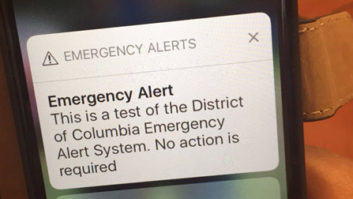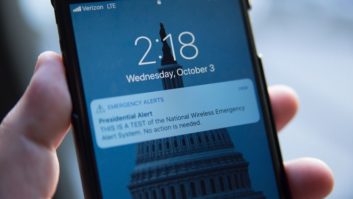Broadcasters have strong opinions about the potential rollout of a new Blue Alert codes by the Federal Communications Commission. Here, Radio World speaks with Clay Freinwald about his thoughts on the issue, including the news that while Washington State will continue to use its existing Blue Alert, it will not be using EAS for it as the FCC has proposed. Clay is a nationally recognized leader of alerting issues among broadcasters. He is also chair of the Washington State Emergency Communications Committee. The opinions expressed are his own.
Radio World: What is your position on the need to establish a Blue Alert with the EAS?
Clay Freinwald: The Blue Alert is similar to the Silver Alert, designed to help locate the elderly that may have become lost. It’s a good idea. However, it does not rise to the level of using the EAS. Silver and Blue Alerts are ideal for social media as well as news items for the electronic media.
RW: Some have said that, despite the good intentions of the proposal, police agencies nationwide already have quick and effective means of reaching the public. What is your take?
Freinwald: We need to understand that EAS is only really effective when all the participants (radio/TV/cable) run the message. At this point the only messages that are required to be aired are those at the federal level, i.e. presidential messages (EANs). Beyond that point, the airing of alerts is 100 percent voluntary, meaning that only the most important messages might get aired, depending on the philosophy of the participant.
Those that are not deemed to be high priority are not likely to be aired. Blue and Silver alerts are likely in the “ignore” category. We need to remember that much, if not most, EAS equipment is pre-programmed how to respond to various event codes due to the large percentage of unattended operations, meaning that this is not an on-the-fly decision but rather a decision that has been pre-made.
This strikes me as being an exercise designed to make some politicians feel they accomplished something without any tangible impact in the end.
RW: It’s been said that the NYPD would have been able to better relay information on major events with a new alert code in place. Would a Blue Alert code offer improvements in some emergency situations?
Freinwald: For the reasons already stated, I do not share this feeling. EAS is not the best vehicle for this type of activity; this is a role for social media.
RW: How does the Law Enforcement Warning alert differ from the Blue Alert? Is your assessment that the existing LEW code is the right way of reaching law enforcement?
Freinwald: The idea of adding another event code is perhaps a misguided concept developed by those who don’t have a good grasp of how EAS actually works. The addition of a new event code is wasteful and unnecessary for the simple reason that the existing LEW could be used without the requirement to spend additional time and money that adding an addition event code to thousands of EAS unit would require.
In the 20-plus years I have been working with EAS, we have never used LEW.
RW: How would a proposed Blue Alert duplicate those efforts?
Freinwald: Many states already have a Blue Alert and a Silver Alert, including Washington State. Just because we have the word “alert” does not mean it’s something that requires the use of EAS.
RW: It’s been said that a mandatory Blue Alert would require the reprogramming of broadcaster EAS ENDECs nationwide. Is this a burden? Can you clarify why?
Freinwald: Certainly, a required-carry Blue Alert would require modification of all existing EAS equipment and this would represent an expense that would likely not be well received. There are already many that view EAS as a wasteful, unfunded federal mandate. This will only add fuel to their argument.
RW: Why would use of a Blue Alert add to public confusion about the current multiple EAS Alert Codes?
Freinwald: Confusion can come from overuse of any alerting system. It’s taken some time for the term Amber Alert to become fully understood and appreciated. Due to the type of system we use with EAS (SAME) there will always be a number of event codes, with each one designed to deal with a specific type of event.
RW: Some argue this proposal sets a bad precedent with possible unfavorable consequences. What might some of those be?
Freinwald: Although a new EAS Alert Code would pose minimal expense, software changes require broadcasters to update their EAS equipment and verify that it continues to operate properly. Updating computer-driven devices is subject to bugs and configuration errors. This process poses a burden on already-struggling broadcasters, especially radio stations, and particularly in situations where EAS sending and receiving equipment is operated at remote locations.
RW: Do you have a sense of what Washington’s stance will be this issue?
Freinwald: Washington State will continue to use its existing Blue Alert, but we will not be using EAS. This is the official policy of the SECC.












